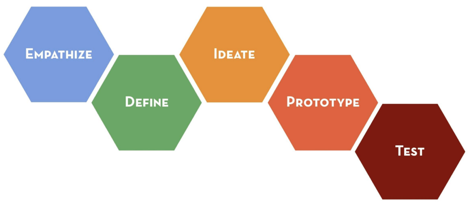Introduction
Have you or your worshipping community ever encountered a tough problem and found yourselves unable to come up with a solution? Then design thinking might be able to help! Design thinking is being used every day by global companies, top universities and people around the world to help solve big challenges.
Typically in problem-solving, the problem and solution are defined within concrete confines — for example, in innovation, we look for the ideal overlap of viability, feasibility and desirability. Design thinking enters the innovation process to help expand the options and imagination into the abstract before coming back down to finalize or define the concrete solution.
Design thinking can also help break down large, complex problems into more discrete yet interconnected segments.
“Great!” you say? Then, let’s get to it. What is design thinking?
Design Thinking: An Overview
 |
Source: Stanford d.School,
|
Design thinking is a method for creative problem-solving that works on an understanding that the best solutions and problem-solving involve the perspectives of those who will use the design — “the user” (ex. customer, member, constituent). By gaining a deep understanding of the user first, design thinking considers whether the problem is a problem at all, helps to uncover assumptions and explores the implications of a potential solution.
To better understand the problem, the users and potential solutions, there are five “modes” within design thinking. While there are many ways to explore these phases, here is how the Stanford d.School (Stanford Design School) defines the five modes:
- Empathize: Empathy is the foundation of user-centered design. The problems you’re trying to solve are rarely your own; they’re those of particular users. Build empathy for your users by learning their values.
- Define: The define mode is when you unpack your empathy findings into needs and insights and scope a meaningful challenge. Based on your understanding of users and their environments, come up with an actionable problem statement: your Point of View. Understanding the meaningful challenge at hand and the user insights you can leverage is fundamental to creating a successful solution.
- Ideate: Ideate is the mode in which you generate radical design alternatives. Ideation is a process of “going wide” in terms of concepts and outcomes — a mode of “flaring” instead of “focus.” The goal of ideation is to explore a wide solution space — both a large quantity and a broad diversity of ideas. From this vast repository of ideas, you can build prototypes to test with users.
- Prototype: Prototyping gets ideas out of your head and into the world. A prototype can be anything that takes a physical form — a wall of Post-it notes, a role-playing activity, an object. In the early stages, keep prototypes inexpensive and low-resolution to learn quickly and explore possibilities.
- Test: Testing is your chance to gather feedback, refine solutions and continue to learn about your users. The test mode is an iterative mode in which you place low-resolution prototypes in the appropriate context of your user’s life. Prototype as if you know you’re right, but test as if you know you’re wrong.
Design thinking is an iterative problem-solving process, meaning that the five phases are not sequential. For example, after prototyping, you might want to go back to empathize with users to understand whether a potential solution will work.
Design thinking also opens up the opportunity to think from different perspectives and in alternative ways to reach a better solution. To explore further, check out the Stanford d.School’s “Design Thinking Bootleg” or IDEO’s design thinking introduction and related resources.
What’s next?
While design thinking often follows or uses the five “modes” outlined above, even this innovative field continues to evolve. Look out for part two of this design thinking story, which will focus on equity design!
References and Other Resources
IDEO, “Design Thinking.”
Stanford d.School, “Design Thinking Bootleg.” Licensed under CC BY-NC-SA 4.0.
Rikke Friis Dam and Teo Yu Siang, “What Is Design Thinking and Why Is It So Popular?,” Interaction Design Foundation, July 2020.
The ELCA Innovation Lab Blog is new! We’d love to hear what you think. If you’ve got a few minutes, complete this short survey. If you have any additional questions or comments let us know at lab@elca.org.
